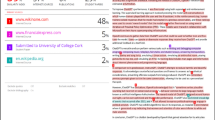Abstract
THE CONTROVERSY OVER CYBERLEARNING, as an integral part of the teaching and learning process in higher education, is growing almost as fast as the technology itself. Unfortunately, there are relatively few empirical studies that provide a comprehensive test of the effectiveness of cyberlearning. This exploratory study compares Cyberlearners with Traditional Learners in a graduate-level MBA course in introductory macroeconomics. The findings appear to provide evidence that cyberlearning can be as effective as traditional classroom learning.
Similar content being viewed by others
References
Baker, W., Hale, T., & Gifford, B.R. (1997). From theory to implementation: The mediated approach to computer-mediated instruction, learning and assessment.Educom Review, 32(5). [Online]. Available: http://www.educom.edu/web/pubs/review/reviewArticles/32542.html [1998, June 8]
Blumenstyk, G. (1998, August 7). California Virtual University doubles its list of course offerings.The Chronicle of Higher Education, 44(48), A23.
Brewer, S.M., & Erickson, D.R. (1997). A tale of two classrooms.Journal of Computing in Teacher Education, 13(3), 20–22.
Burdman, P. (1998, September 13). Cyber U.Orange County Register Connect. pp. 1, 9.
Collins, M.A.J. (1996). A successful experiment with an electronic bulletin board in a large class.Journal of College Science Teaching, 26(3), 189–91.
Escalada, L.T., & Zollman, D.A. (1997). An investigation on the effects of using interactive digital video in a physics classroom on student learning and attitudes.Journal of Research in Science Teaching, 34(5), 467–89.
Gross, P. (1997). Engaging the disengaged: How is it different when using distance education? In: Walking the Tightrope: The Balance Between Innovation and Leadership.Proceedings of the 6 th Annual International Conference of the Chair Academy (Reno, NV, February 12–15, 1997). (ERIC Document Reproduction Service No. JC 970 185)
Kerka, S. (1996).Distance learning, the Internet, and the World Wide Web (Report No. EDO-CE-96-168). Columbus, OH: ERIC Clearinghouse on Adult, Career, and Vocational Education. (ERIC Document Reproduction Service No. ED 395 214)
Kosakowski, J. (1998).The benefits of information technology (Report No. EDO-IR-98-04). Syracuse, NY: ERIC Clearinghouse on Information and Technology. (ERIC Document Reproduction Service No. ED 420 302)
Kulik, J. A. (1994). Meta-analytic studies of findings on computer-based instruction. In E. L. Baker & H. F. O’Neil, Jr. (Eds.).Technology assessment in education and training. Hillsdale, NJ: Lawrence Erlbaum.
Lewis, D.C., Treves, J.A., & Shaindlin, A. B. (1997). Making sense of academic cyberspace: case study of an electronic classroom.College Teaching, 45(3), 96–100.
Massy, W.F., & Zemsky, R. (1995, June). Using information technology to enhance academic productivity. Paper prepared for Educom Conference on Academic Productivity, Wingspread Group on Higher Education. [Online]. Available: http://educom/edu/program/nlii/keydocs/massy.html [1998, June 8]
McCollum, K. (1997, February 21). A professor divides his class in two to test value of on-line instruction.The Chronicle of Higher Education, 43(24), p. A23.
Monaghan, P. (1995, February 10). Technology and the unions: Faculty labor leaders air hopes and concerns as colleges enter the electronic era.The Chronicle of Higher Education, 41(22), A17.
Moore, M.G. (1989).Effects of distance learning: A summary of the literature. Paper for Congress of the United States, Office of Technology Assessment.
Navarro, P., with Kahr, R. (1998).The Power of Macroeconomics. [CD-ROM]. Boston: Irwin/McGraw-Hill.
Navarro, P. (1998). Notes from the electronic classroom.Journal of Policy Analysis and Management, 17(1), 106–115.
Pascarella, E.T., & Terenzini, P.T. (1991).How college affects students: Findings and insights from twenty years of research. San Francisco: Jossey-Bass.
Rumble, G., & Harry, K. (Eds.). (1982).The distance teaching universities. London: Croom Helm.
Russell, T.L. (1998).The “no significant difference” phenomenon (4th ed.). Raleigh, NC: North Carolina State University.
Saba, F. (1996). Introduction to distance education.Distance Education Report. [Online]. Available: http://www.distance-educator.com/intro.htm [1998, August 8]
Saba, F. (1998). Discontent with the use of technology in higher education.Distance Educator, 2(8). [Online]. Available: http://www.distance-educator.com [1998, August 15]
Samuelson, P.A., & Nordhaus, W.D. (1998).Macroeconomics (16th ed.). Boston: Irwin McGraw-Hill.
Sherry, L. (1996). Issues in distance learning.International Journal of Educational Telecommunications, 1(4), 337–365.
Steiner, V. (1995).What is distance education? [Online] Available: http://www.wested.org/tie/dlrn/distance.html [1998, August 26]
Sun Associates. (1997).Educational technology integration: Basic technology tools for educators. [Online]. Available: http://www.sun-associates.com/resources/bastools.html [1998 June 3]
Young, J.R. (1997, October 3). Rethinking the role of the professor in an age of high-tech tools.The Chronicle of Higher Education, 4(6), A26-A28.
Young, J.R. (1998, May 15). A year of web pages for every course: UCLA debates their value.The Chronicle of Higher Education, 44(36), A29.
Zhang, P. (1998). A case study on technology use in distance learning.Journal of Research on Computing in Education, 30(4), 398–419.
Author information
Authors and Affiliations
Additional information
Peter Navarro is an Associate Professor of Economics and Public Policy at the Graduate School of Management, University of California, Irvine. He received his Bachelor’s degree in liberal arts from Tufts University and holds a Master’s in Public Administration from the Kennedy School of Government as well as a Doctorate in economics from Harvard University. He is the author of four books, includingThe Policy Game andThe Dimming of America. He is also the author of two instructional CD-ROMs published by Irwin-McGraw Hill,The Power of Macroeconomics andThe Power of Microeconomics. His articles have appeared in a wide range of publications, from theJournal of Business andJournal of Policy Analysis and Management to theHarvard Business Review andPublic Interest.
Judy Shoemaker is Director, Office of Research, Evaluation and Grants for the Division of Undergraduate Education at the University of California, Irvine. She received her doctoral degree in Educational Psychology and Research Methods from the University of Kansas. Previously, she served as Director of Placement Testing at UCI, Program Officer for the U.S. Department of Education, and Senior Research Associate for the National Assessment of Educational Progress. She has published articles in various educational research journals, was a member of the Board of Directors for the National Council of Measurement in Education, and has served as a member of the Editorial Advisory Board forApplied Measurement in Education. Her professional interests and expertise are in the areas of assessment and program evaluation in higher education.
Rights and permissions
About this article
Cite this article
Navarro, P., Shoemaker, J. The power of cyberlearning: An empirical test. J. Comput. High. Educ. 11, 29–54 (1999). https://doi.org/10.1007/BF02940841
Issue Date:
DOI: https://doi.org/10.1007/BF02940841




